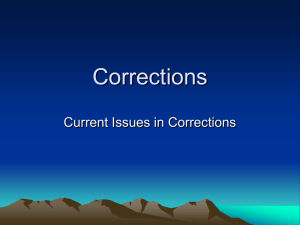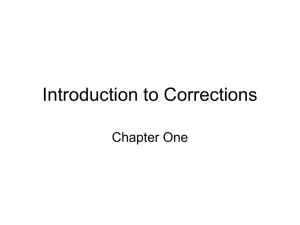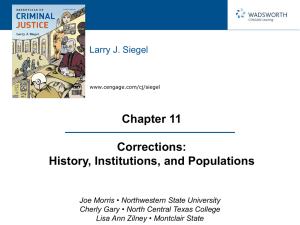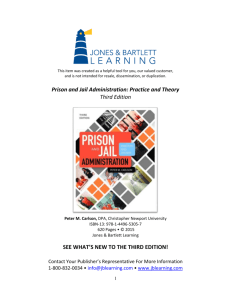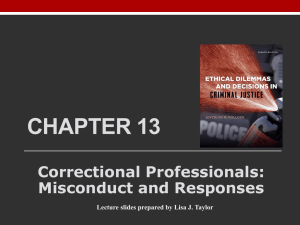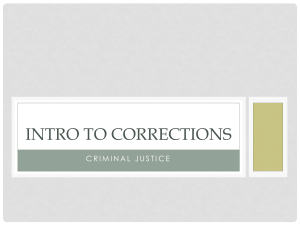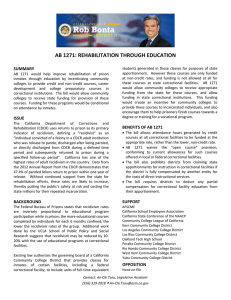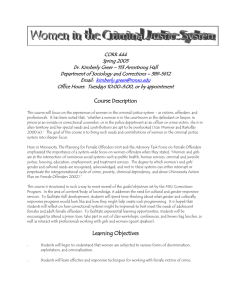Career Development in Corrections
advertisement
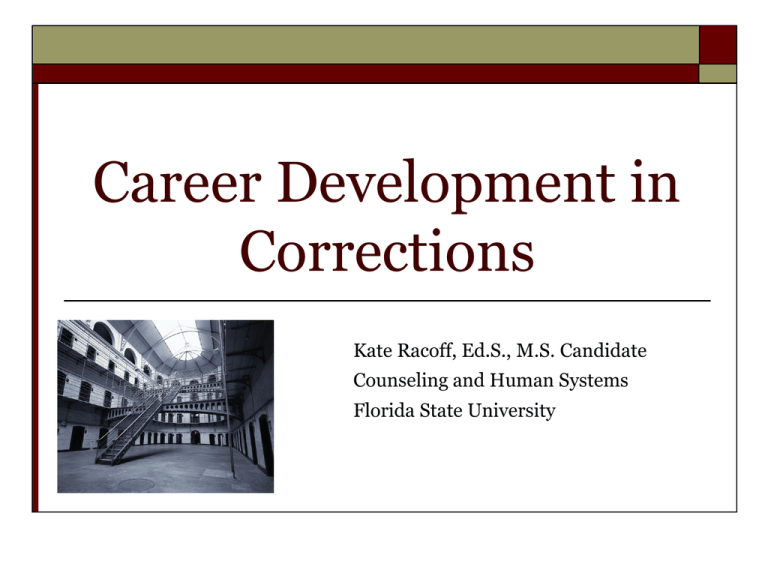
Career Development in Corrections Kate Racoff, Ed.S., M.S. Candidate Counseling and Human Systems Florida State University Presentation Overview Why is This Important? Current Programs New Direction CIP Approach Utilizing CIP in Corrections Why is This Important? Offenders Roughly 1,600 individuals a day will be released from prisons Inability to obtain employment contributes to recidivism Potential problems they will face: Unemployment Homelessness Substance abuse Mental health problems Social stigma Domestic issues Why is This Important? Female Offenders In 2004, 104,848 women were in prison Fastest growing prison population Women may have more obstacles due to: Social problems Lack of self-esteem Social embarrassment of felon status Lack of assertiveness Vocational programs tend to be restricted to “female occupations” Some research indicates difference in career variables (i.e. career thoughts and interests) Current Programs Most correctional facilities offer the following services: Vocational Academic Transitional Many facilities exceed traditional services New Direction “Human Capital” Approach Examine numerous layers of career development issues Improvement in skills + attitudes toward work + self-esteem = increased employment opportunities upon release Thoughts surrounding career Values, interests, and skills How and where to find career information How to make a decision Feeling confident about decision made How can this be accomplished? Cognitive Information Processing The Pyramid of Information Processing Domains “Content” of career problem solving and decision making Metacognitions Decision-making skills Self-knowledge Occupational knowledge Cognitive Information Processing The CASVE cycle “Process” of career problem solving and decision making Communication Execution Analysis Valuing Synthesis Utilizing CIP in Corrections Identifying, challenging, and altering negative thoughts Identifying occupations that are congruent with interests Learning how to solve problems to decrease future difficulties Questions??? Presentation materials posted at: www.career.fsu.edu/techcenter/ Please feel free to email me with questions or comments: kracoff@gmail.com References - Offenders Harrison, P. M. & Beck, A. J. (2005). Prisoners in 2004. Bureau of Justice Statistics Special Report, U.S. Department of Justice. James, D. J. & Glaze, L. E. (2006). Mental health problems of prison and jail inmates. Bureau of Justice Statistics Special Report, U.S. Department of Justice. Kirchner, E. O., Kennedy, R. E., & Draguns, R. G. (1979). Assertion and aggression in adult offenders. Behavior Therapy, 10, 452-470. Shover, N. (1991). Are prisons any better? Twenty years of correctional reform. Contemporary Sociology, 20, 437-438. Travis, J., Solomon, A. L., & Waul, M. (2001). From prison to home: The dimensions and consequences of reentry. Urban Institute Justice Policy Center. Retrieved March 15, 2007 from Family and Corrections Network site: http://www.fcnetwork.org References – Female Offenders Alemagno, S. & Dickie, J. (2005). Employment issues of women in jail. Journal of Employment Counseling, 42, 67-74. Buck, M. (2004). Women in prison and work. Feminist Studies, 30, 451-455. Case, P. & Fasenfest, D. (2004). Expectations for opportunities following prison education: A discussion of race and gender. The Journal of Correctional Education, 55(1), 24-39. Railey, M. G. & Peterson, G. W. (2000). The assessment of dysfunctional career thoughts and interest structure among female inmates and probationers. Journal of Career Assessment, 8(2), 119129 Young, D. S & Mattucci, R. F. (2006). Enhancing the vocational skills of incarcerated women through a plumbing maintenance program. Journal of Correctional Education, 57(2), 126-140. Van Octen, M. (1993). Legal issues and the female offender. In Female offenders: Meeting the needs of a neglected population. Laurel, MD: American Correctional Association. References – Career Development Keim, J., Strauser, D. R., & Ketz, K. (2002). Examining the differences in career thoughts of women in three low socioeconomic status groups. Journal of Employment Counseling, 39(1), 31-42. Railey, M. G. & Peterson, G. W. (2000). The assessment of dysfunctional career thoughts and interest structure among female inmates and probationers. Journal of Career Assessment, 8(2), 119129. Reardon, R. C., Lenz, J. L., Sampson, J. P., Jr., & Peterson, G. W. (2006). Career development and planning: A comprehensive approach (2nd ed.). Mason, OH: Thomson Corporation. Sampson, J. P., Jr., Reardon, R. C., Peterson, G. W., & Lenz, J. G. (2004). Career counseling & services: A cognitive information processing approach. Belmont, CA: Brooks/Cole-Thomason Learning. Shadd, M. & Mann, R. (2006). A fundamental attribution error? Rethinking cognitive distortions. Legal and Criminology Psychology, 11(2), 155-177. Strauser, D. R., Lustig, D. C., Cogdal, P. A., & Ayse, C. U. (2006). Trauma symptoms: Relationship with career thoughts, vocational identity, and developmental work personality. The Career Development Quarterly, 54(4), 346-360. References – Career Development in Corrections Bailey, D. M. (2006). Career development services within Maryland correctional educational facilities. Retrieved May 25, 2007 from http://www.nicic.org/Library/021829 Filella-Gui, G. & Blanch-Plana, A. (2002). Imprisonment and career development: An evaluation of a guidance programme for job finding. Journal Career Development, 24(1), 55-68. Gerber, J. & Fritsch, E. J. (1995). Adult academic and vocational correctional education programs: A review of recent research. Journal of Offender Rehabilitation, 22, 119-142. National Institute of Corrections (n.d.), Offender workforce development. Retrieved June 5, 2007 from http://www.nicic.org/OWD Oswald, J. (2005). Job fairs in America’s state prisons: Summary of findings on research. Journal of Correctional Education, 56(2), 174-185. Pavis, R. (2002). Preparing federal prison inmates for employment after release: An innovation at the federal bureau of prisons. Journal of Correctional Education, 53(4), 146-149. PRIDE Enterprises (n.d.) Value, jobs, and future with PRIDE. Retrieved June 15, 2007 from http://www.pride-enterprises.org/default.aspx Vernick, S. H. & Reardon, R. C. (2001). Career development programs in corrections. Journal of Career Development, 27(4), 265-277.
